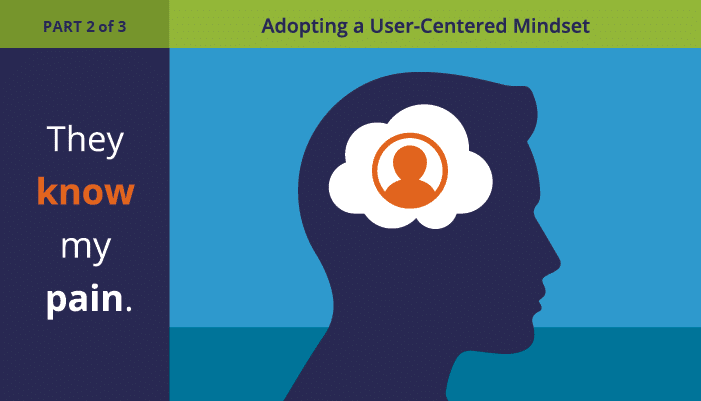Brand Insights
For Health Science Executives
The Key to Innovation in Healthcare Technology
The Key to Innovation in Healthcare Technology
Adopting a User-Driven Mindset (Part 2)

The same methodology used by Apple and IBM can help you consistently deliver products and services that drive customer loyalty.
In Part 1 of this three-part series, we discussed how cultivating a companywide, user-centered mindset can help health technology companies streamline decision-making and increase ROI. Here, you’ll learn how, and especially why, to apply that mindset for the successful development of health tech products and services through a methodology called design thinking.
In the experience economy, customers expect personalized engagement with your brand. Delivering a consistently positive experience—one that makes customers think, “They know my pain.”—pays off in customer loyalty. NIKE, Apple, IBM and GE have made design-thinking methodologies a core part of their cultures, and they all boast a unique connection with their customers. They don’t begin with a product or brand and then work to convert prospects into customers. Instead, they seek to understand their existing customers’ needs and wants. They encourage hands-on and minds-on collaboration around customer expectations and bring actual users into the product development process early.
Health tech companies can use design thinking to gain control over new product development (NPD) initiatives and consistently deliver successful outcomes. Executive teams that integrate users into the design process truly understand what users want, which makes delivering it easier—and more authentic—from the start.
Benefits of Design Thinking
Three key benefits the design thinking process offers health tech companies that use it:
- Create products and services that resonate with customers.
- Ensure a positive ROI from the start.
- Reinforce customer loyalty and brand advocacy on an ongoing basis.
The health science industry is historically slow to change, and innovative ideas are often distorted by heavy-handed applications of policies and procedures. The well-being of real patients is at stake, and avoiding regulatory missteps is critical. However, caution at the expense of innovation isn’t the answer. Design thinking relies on a mindset that emphasizes clear and repeatable processes that are regularly tested and refined to improve the customer experience, making it a natural fit for science-based industries like health tech.
FACT: McKinsey research reports S&P 500 companies outperformed the rest of the index by 211% by investing in design processes, capabilities and leadership.
When health tech companies trade risky and expensive guesswork for design thinking methodologies, success is almost inevitable because every NPD decision is based on the needs, preferences and challenges of actual users. Once you’ve fostered a companywide shift in mindset and put a robust user-experience (UX) toolbox in place, your team will regularly iterate within that system—and innovation will naturally follow. Design thinking methodologies also provide much-needed focus so your team can concentrate energy and resources in fewer places with proven results.
Roger Martin, strategy advisor to global companies including Procter & Gamble, Lego, Ford, BHP & Verizon, sums up the benefits of this approach in an article for Medium: Confident companies do less by doing what they do best. He explains that focusing on depth versus breadth in all you do can help prevent spreading resources thin with little evidence that being everything to everyone will pay off. By narrowing the focus and addressing the feedback of core customers, executives can go all in on ideas knowing they will work because customers have told them as much in surveys, behavior tracking, and direct customer feedback.
Getting Started: Unify Your Team’s Focus
Inspiring consensus and focus among all stakeholders is critical to the success of companies that commit to UX and design thinking, but it’s not enough. Operationalizing a user-centered mindset also requires radical collaboration among stakeholders—a collective agreement to continually put customer preferences, goals and pain points first, so you can build a brand people believe in.
Health tech leaders (especially larger organizations) may want to consider creating an innovation leadership team (ILT) that is committed to implementing design thinking and regularly uses tools like prioritization grids to surface the most pressing problems and maintain a structured, objective approach to solving them. To give your customers precisely what they want, consider inviting one or two of your super-users to join. They have a stake in what you are creating because they may want to buy and use it. Getting their feedback regularly will help keep the customer experience top of mind.
In Part 3 of this series, we dive further into the specific tools design thinking experts use to meet customer needs and drive revenue.
Conclusion
Cultivating a user-driven culture is business critical for the success of your brand and product development teams whether you are a B2B or B2C organization. Design thinking companies with names like Apple and Starbucks that garner a premium from customers prove this is no accident. UX and its underlying design thinking methodologies confer a distinct competitive advantage. When decisions are based on user opinion and experiences, customers know what to expect. Joining this exclusive list of power brands will require a deep understanding of UX and design thinking methodologies and a willingness to commit to a new way of thinking. Properly applying design thinking requires special expertise that can be hard to find within health science companies today. As a certified design thinking coach, I often help health tech executives apply design thinking to ensure they are delivering solutions their customers need and want.
Are you ready?
Curious how design thinking can empower your innovation team? Let’s connect. Send me a message through LinkedIn or email me, karan@cushmancreative.com, and tell me more about your situation.